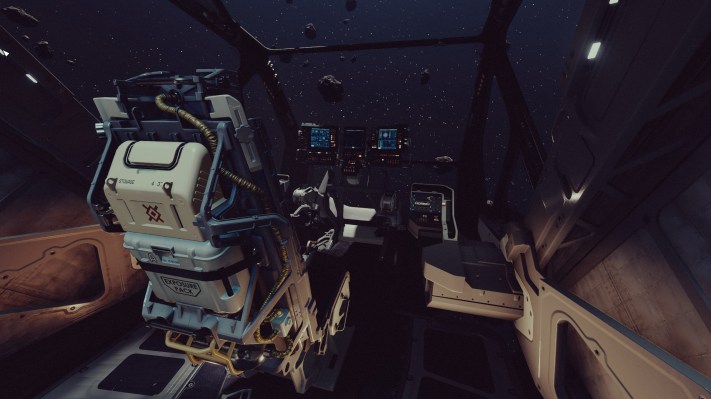The long-awaited “Skyrim in space,” Starfield, is out today after many years in development over at Bethesda. It’s ambitious and lavishly produced, but despite its size it lacks the sense of wonder and vastness that its pastoral predecessor epitomized.
(I and my colleague Darrell both played the game and came away with differing impressions — he also played on console while I played on PC.)
Starfield follows the adventures of your character in the 2300s, when hundreds of star systems have been colonized but much of what’s out there is still unknown. You fall in with Constellation, a group of explorers on the trail of a set of mysterious artifacts that hint at a greater presence at work in the galaxy… and your destiny! (Minor early game spoilers ahead.)
Sound familiar? It should, as this is the general shape of half the space-based adventures out there. But where Starfield sets itself apart is in the scale of the game world and the player’s freedom to explore it, boasting an open galaxy of a thousand planets. Admittedly, other games also attempt to set themselves apart this way, but let’s move on.
Like Skyrim, once you get past a few initial missions that introduce the characters and mechanics, you’re more or less free to explore. But here we hit our first, and perhaps most important, issue.
While its august predecessor and other open world games like Tears of the Kingdom, Elden Ring, and Horizon: Forbidden West take place in huge, continuous lands dotted with points of interest, Starfield’s open world is spread over dozens of star systems and individual planets, which leads to a fundamentally less compelling form of exploration.
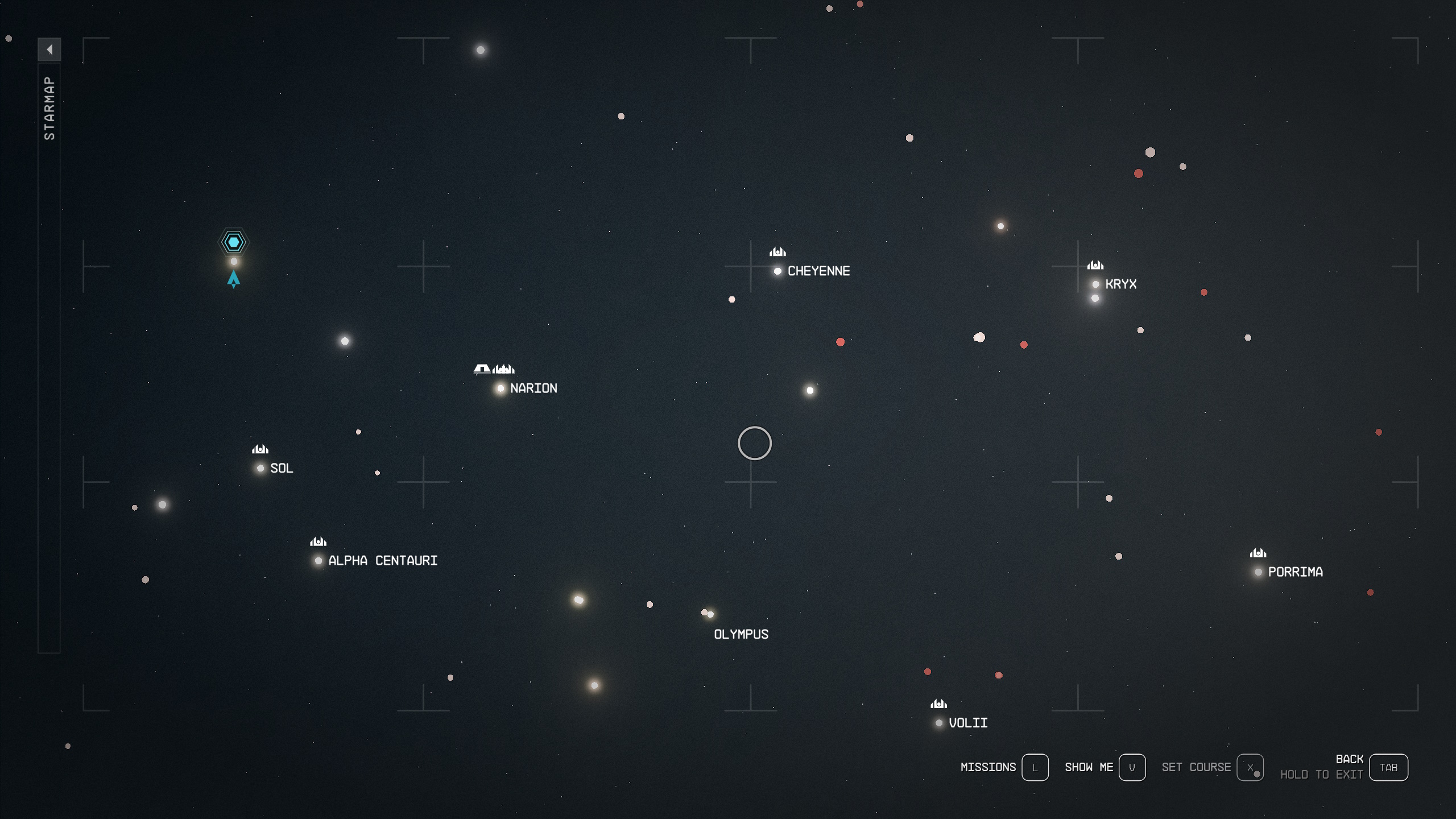
Dots… dots everywhere!
Instead of walking or riding (or as in countless other space exploration games, flying) from point A to point B and finding activities and locations as you go, you select locations from the map: system, planet, and landing location.
But you don’t actually fly there: the menu just takes you directly there via loading screen. I don’t feel like I’m exploring a vast galaxy so much as I’m ordering a stellar object a la carte. Hmm, I’ll try the Level 20 Atria VI, 2nd moon. And boom, there you are. Now land in the middle of nowhere and walk a few hundred meters to the only visible point of interest.
Maybe this won’t bother others as much as it does me. But part of the reason I play open world games at all is the sense of wonder, craft, and interconnectivity, best expressed in the (inevitable) moment your character steps out onto a precipice or out of a vault and the landscape opens itself up in front of you. That moment of wonder and anticipation simply doesn’t exist in Starfield. In a way the review can end there — with the game completely neglecting to offer what to me is one of the most important aspects of the genre. But that would be unfair, as Starfield undoubtedly has its charms.
Props and planets
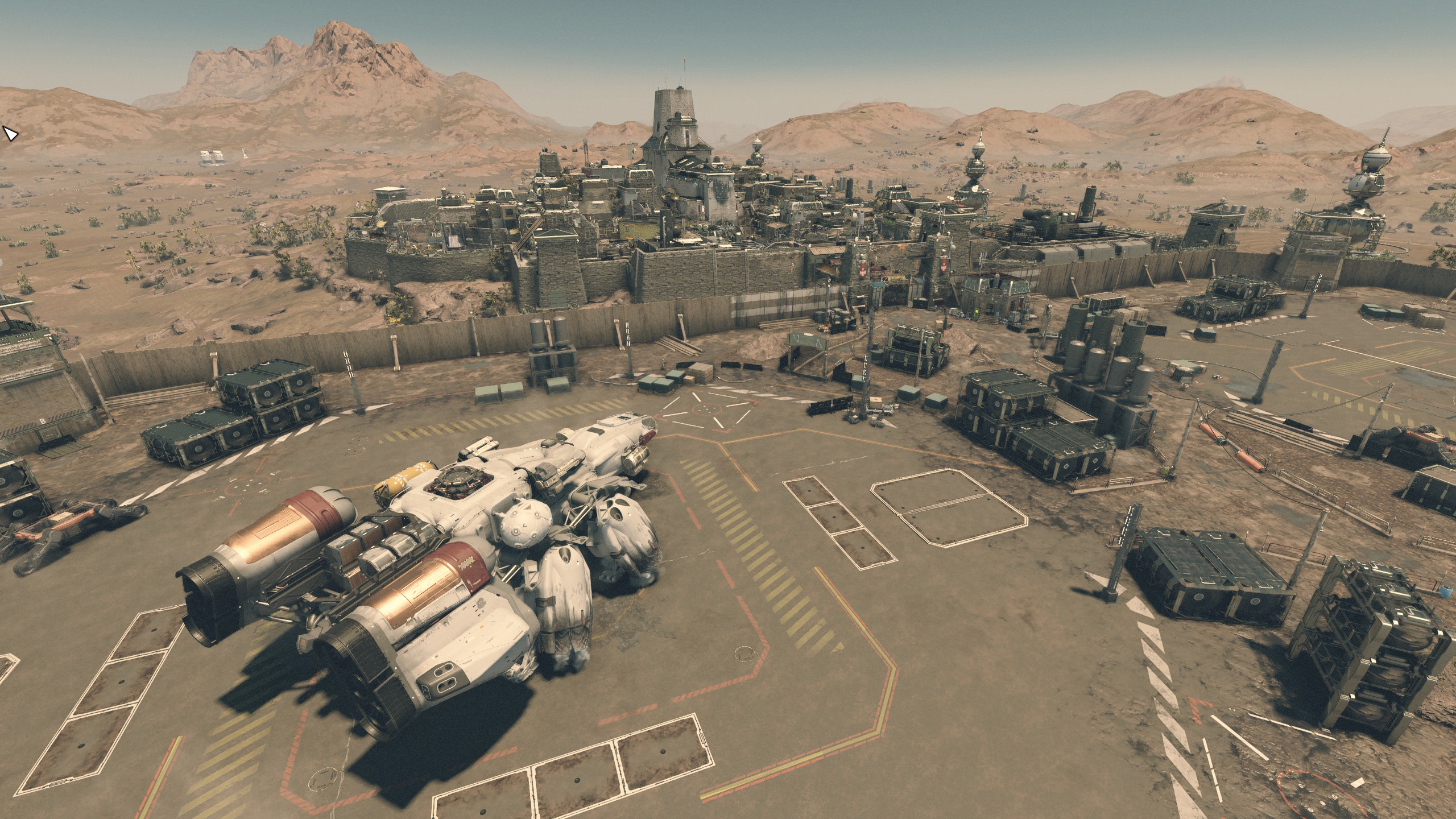
Image Credits: TechCrunch / Bethesda
For one thing, the actual locations are really beautifully realized. The environment and object design in this game is absolutely fantastic. The aesthetic is marvelous and the execution is impeccable. I’m doing a whole separate post on some of the wonderful gadgets, interfaces, doors, and other machines I’ve encountered — I never thought I’d look forward in a game to seeing how a new door opens, but it’s a joy every time in this game. Buildings are realistically laid out, with bedrooms and bathrooms, workspaces, kitchens, and chock full of ordinary objects and snacks. So many snacks.
I also really enjoy the spaceship design, interior and exterior, so it’s a shame you seldom have any real reason to look at it. You can freely redesign your ship basically from scratch (Darrell’s favorite part, so I’ll let him elaborate on it), but ultimately when you’re in space combat you’ll probably be in first person, and the rest of the time the ship is just set dressing for your fast travel.
The cities, from shiny, clean New Atlantis to Cyberpunk-lite Neon and beyond, are also fairly impressive, with plenty of NPCs wandering around, mumbling about potential quests, and shops offering opportunities to stock up or commit various forms of theft.
And there are plenty of unique locations to explore on story missions, which are deliberately designed and full of character. “Environmental storytelling” is a Bethesda core competency and it shows here.
Non-flagship locations you find, however, tend to fall into one of a few categories: caves full of space pirates, abandoned facilities full of space pirates, and space stations full of space pirates. Some of them are mercenaries, or “spacers,” but unless you are currently on a faction quest for them or something, they’re all just spacesuits pointing guns at you.
So you’ll be shooting them a lot — there’s no other way forward most of the time. If you were hoping to sneak through vents or hack your way through, sorry. Though a few missions rely on these tricks, for the most part it’s kill or be killed. And combat is fun but pretty basic. You’ll trade shots with anonymous (but cool) looking spacesuits peeping out of cover, or flank them with your jetpack — always satisfying, even if it feels a little unfair against their simple AIs. Most areas have a boss spacesuit with multiple health bars: utter bullet sponges that can take dozens or hundreds of shots to wear down.
If this is a little disappointing to those hoping for a Deus Ex-style choose-your-own-adventure, I’m with you, but it bears remembering that the core gameplay loop of Skyrim was similarly “find a cave/tomb/base, annihilate all occupants and steal anything of value.” Eventually we all became stealth archers — same here, but without the stealth.
There’s a good variety of weapons, using a bewildering array of ammo types (some of which are rare but many of which you’ll have thousands of rounds of after a few hours), and you can freely modify them once you acquire the pertinent skill. I’ve had more luck picking up advanced guns by venturing into higher-level areas, but the freedom to opt at nominal cost for different ranges and styles is appreciated.
Mission monotonous
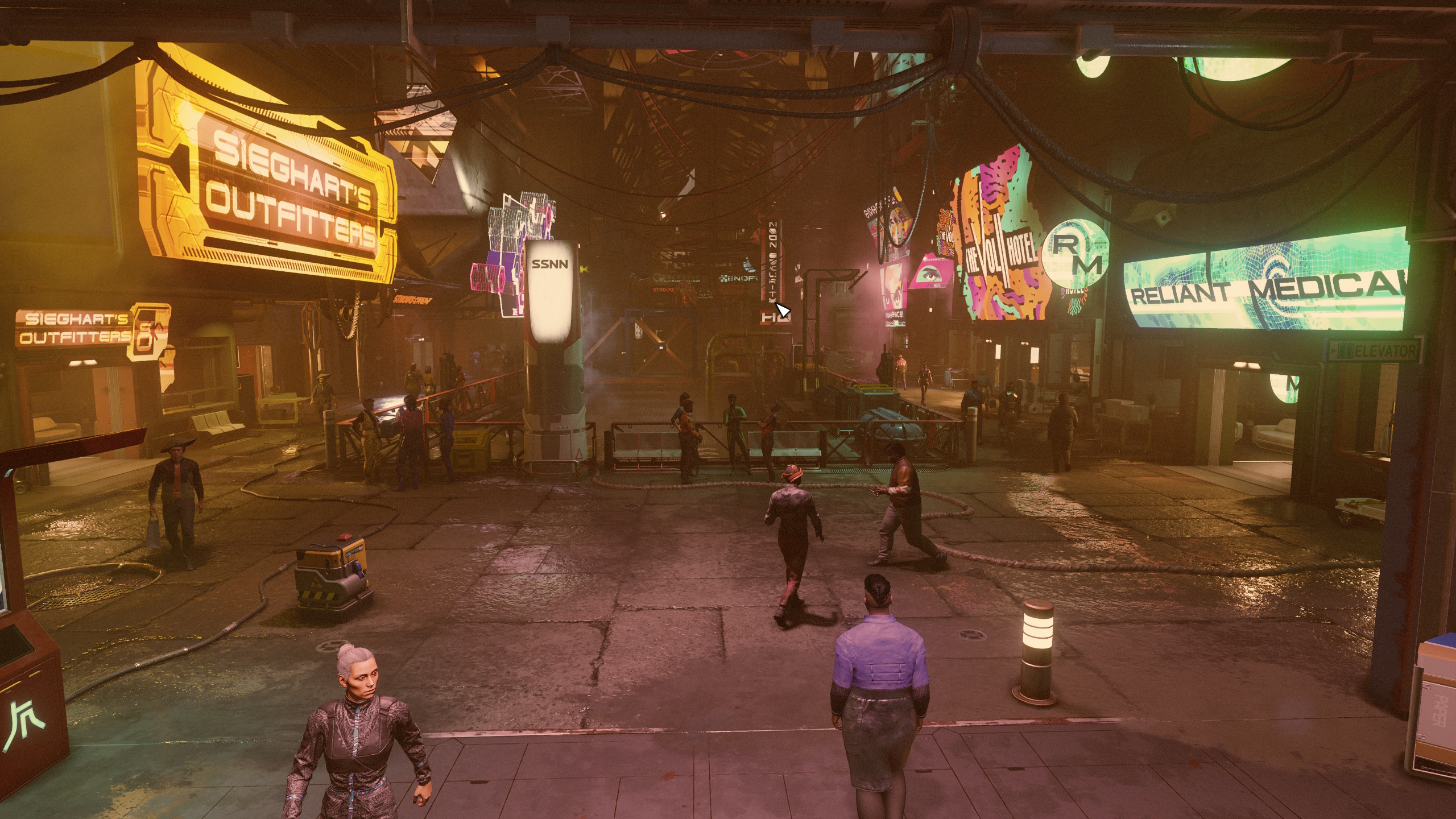
Image Credits: TechCrunch / Bethesda
The main and faction missions have dialogue and some real rewards — which are interesting to find out on your own so I won’t spoil them here. Keep your expectations mid; it’s not much more impactful or interesting a story as Skyrim’s, nor is it better told, nor are the characters (including your immortal puppy-dog companions) much more memorable or helpful. But they’re better than the “task”-level side quests, which are thick on the ground and uniformly pretty weak.
I took on one of the first and seemingly simplest quest board tasks: to find a planet in a neighboring system that had some kind of solar seasons. Right away I’m thinking, despite every stellar object being inhabited long enough ago to have abandoned facilities of some kind, this information isn’t public record? Anyway, I had to visit each of half a dozen worlds and all of their moons individually (via menu) to scan them (via menu), then explore some on foot scanning everything in sight to find which had the “trait” — none, that I could tell. I gave up on this unrelentingly tedious quest and decided to never visit the board again.
But in the process, I found some interesting planets… just kidding. The planets were all pretty samey, and I found an exact copy of a facility I had encountered a couple hours earlier — a perfect copy in every respect, though the space pirates were of a different flavor. This has happened many times since then: same facility, same layout, same enemies, same dead scientists or colonists in the same positions, same chests in the same rooms. (All while your companion shouts the same battle cries and non sequiturs.)
On one moon-scanning surface expedition, I saw a ship land a ways off. I bounced over to see if I could help its occupants, or shipjack them. I found the captain ambling around a nearby building. She needed ship parts to fix their ship, she said. I didn’t have any. But ten feet away was an unlocked chest with one (1) ship parts inside (and some money and a gun, and some snacks). I gave her the ship parts, thinking perhaps this would be the start of a quest chain. She said “wow, thanks!” and continued her walk. The end!
And I found a moon called Worthless, presumably so-called because it is a barren rock with not only no life on it, but only two mineral resources to scan and collect; some planets have 6 or 7, plus as many flora and fauna to find. Nevertheless, what did I find but a science base — and amazingly, it was occupied, not by pirates… but botanists! A team of botanists on an utterly barren planet. And when I walked up to one, he grabbed me to say that they had been attacked in a nearby cave by the local monsters. But the planet has no monsters, I wanted to tell him. I went to the cave, a two minute walk away, and found their friend about 50 feet in. Sure enough, no monsters to be found, there or anywhere else on the planet. Fast traveled back to the outpost and collected my 4,000 credits.
What I’m trying to say is that if the 950 planets that aren’t part of some main quest chain are going to be filled with this kind of thing, I see little reason to visit. It more or less put me off “exploring” altogether. If you stick to the larger scale scripted quests (these are clearly communicated), and only bother with unique locations (also pretty easy to tell apart) you’ll have a less tedious time of it than I did. There are fun stories to be encountered here and different ways of navigating them, but you have to learn to spot the fool’s gold.
Audio logs and visual cues, signifying nothing
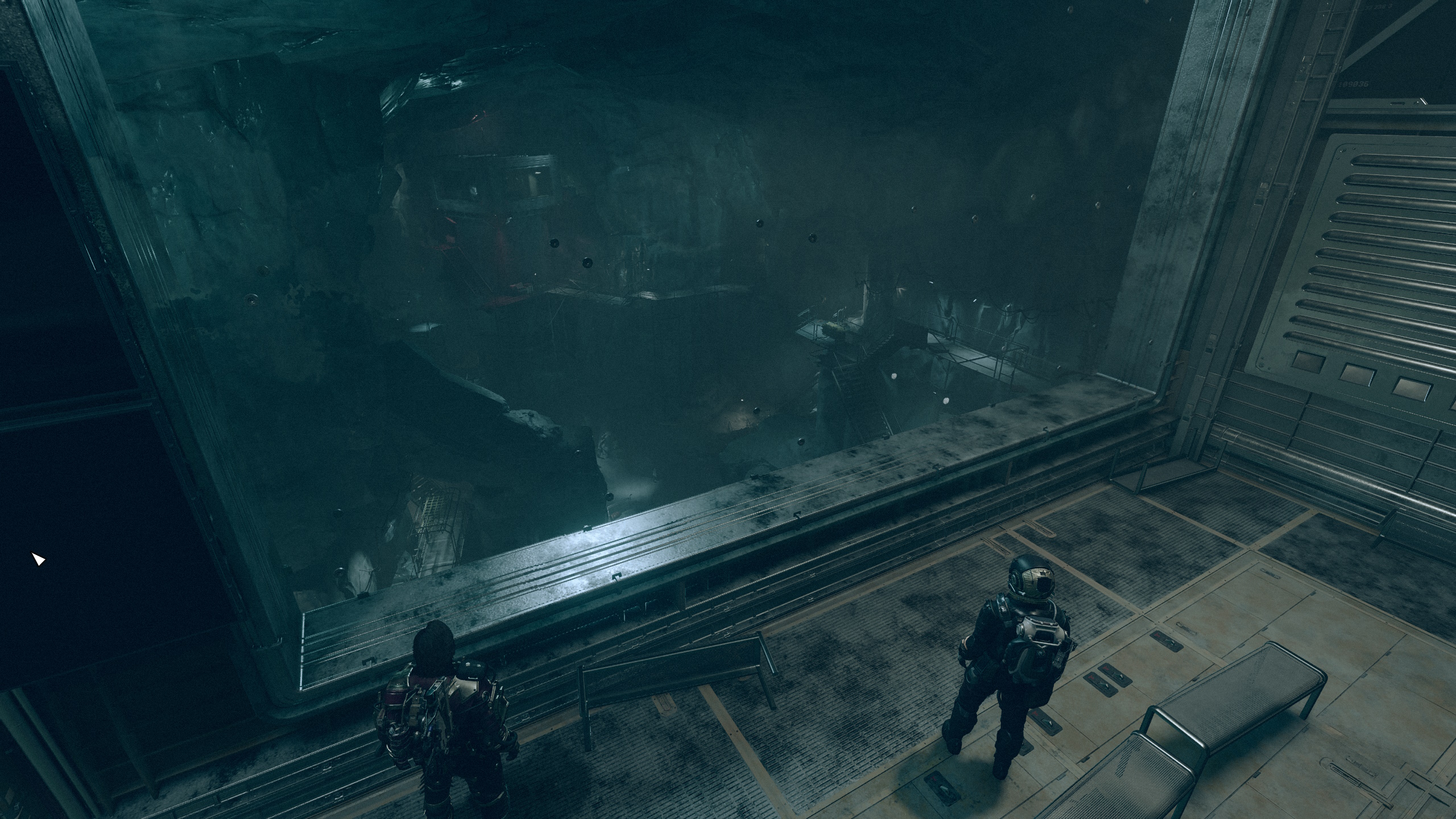
Image Credits: TechCrunch / Bethesda
Although Starfield has grown on me as I’ve played it — I’ve put in many hours even as I catalogued its shortcomings — I feel like there’s something missing at the very heart of it. (I thought it was too cruel to title the review “Mass Defect” but I suspect others less kind may take the opportunity.)
And I felt it from the start. The very first mission has you exploring an outpost where scratches on the walls, messy bodies, and various logs describe a project to equip some terrible sharp-clawed creature with a device to make it into a bioweapon. Of course this has gone wrong and everyone’s dead. As you work your way through, the expectation that one of these creatures will appear grows and grows. You emerge onto the roof, an obvious final confrontation point, and are attacked! …By space pirates.
There never was a creature — it was a fake-out, a story about as relevant to your playthrough as any of the Dickens books seemingly everyone in the galaxy is reading (I jettisoned six copies of Hard Times from my ship! I need that inventory space). Or if there is one, it was too valuable a payoff for them to just give you without 10 or 12 more jumps and dialog trees. Most, though not all, of the missions and locations I experienced echoed this in some way, whether they were procedural or crafted. Like a lackluster main course smothered in garnish, all the parsley and croutons are there to disguise the fact that you’re not playing Skyrim in space, you’re playing a decent corridor shooter with extremely laborious level selection.
You want to explore the galaxy, but you can’t, because there is no galaxy, only more menus. What you do encounter, while it’s rendered beautifully a lot of the time, is too often frustratingly banal. You can still have a good time, and I certainly have as I’ve embraced the game for what it is. Many people want to romp through space and blast pirates and robots (and behave more badly than I did, probably) and don’t really care about that absence of wholeness and wonder. But after years of hype and the advances to the genre, I can’t help but feel it falls far short of its own ambition, and likely the expectations of gamers.
There’s also every chance this review will grow irrelevant as the game is improved on, modded, and refined the way Skyrim has been for a decade. Let’s hope Starfield shines brighter in the future.
